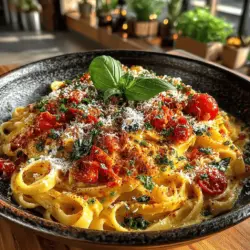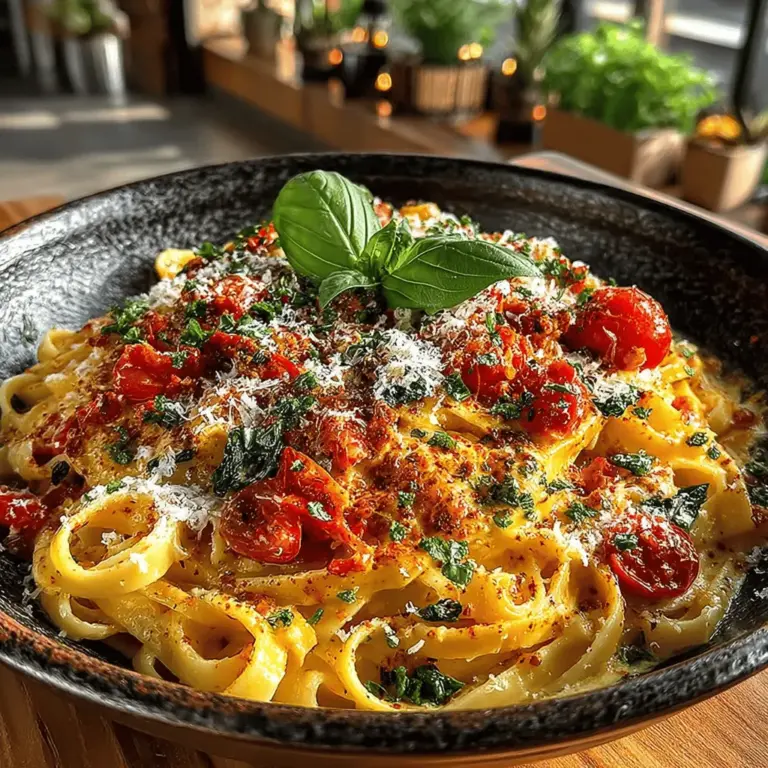Creamy Tomato Basil Pasta: A Comfort Food Classic
When it comes to comfort food, few dishes can evoke the same sense of warmth and satisfaction as creamy pasta. The rich, velvety textures combined with the vibrant flavors of fresh ingredients create a culinary experience that is both indulgent and nourishing. Among the myriad of pasta recipes available, Creamy Tomato Basil Pasta stands out as a delightful option that seamlessly marries simplicity with sophistication. This dish not only tantalizes the taste buds but also offers an inviting aroma that fills your kitchen, making it the perfect meal for family dinners or casual gatherings with friends.
Creamy Tomato Basil Pasta is a dish that embodies the essence of Italian cooking—fresh, high-quality ingredients are at the forefront. The use of ripe tomatoes, fragrant basil, and rich cream combines to create a sauce that clings beautifully to the pasta, providing a comforting and delicious experience. Whether you’re a novice in the kitchen or an experienced home cook, this recipe is designed to be accessible and straightforward, allowing you to serve up a plate of gourmet pasta with minimal effort.
Understanding the Ingredients
To truly appreciate the beauty of Creamy Tomato Basil Pasta, it’s essential to understand the key ingredients that contribute to its delightful flavor profile. Each component plays a crucial role in shaping the dish, and selecting the right ingredients can elevate your pasta to new heights.
Pasta: Types and Recommendations
The foundation of any pasta dish is, of course, the pasta itself. For this recipe, both fettuccine and penne are excellent choices. Fettuccine, with its wide, flat noodles, provides a luxurious surface for the creamy sauce to cling to, while penne’s tubular shape allows for pockets of flavor. Regardless of the type you choose, opt for high-quality pasta made from durum wheat for the best texture and taste.
Olive Oil: Importance of Using Extra Virgin
Extra virgin olive oil is a staple in Italian cuisine and serves as the base for many sauces. Its robust flavor enhances the dish, providing a fruity undertone that complements the acidity of the tomatoes. Using high-quality extra virgin olive oil not only contributes to the flavor but also offers health benefits, including heart-healthy fats and antioxidants.
Garlic: Role in Enhancing the Dish’s Aroma and Taste
Garlic is a culinary powerhouse that adds depth and aroma to any dish. In this pasta recipe, sautéed garlic serves as the aromatic backbone, infusing the oil with its distinct flavor. When cooked just right, garlic becomes sweet and caramelized, enhancing the overall taste of the dish. Be cautious not to overcook it, as burnt garlic can introduce a bitter flavor that detracts from the creamy sauce.
Diced Tomatoes: Fresh vs. Canned
While fresh tomatoes can certainly be used in this recipe, canned diced tomatoes are often recommended for their convenience and consistent flavor. Canned tomatoes are harvested at peak ripeness and packed quickly, retaining their natural sweetness and acidity. Look for high-quality canned tomatoes, preferably San Marzano, for a rich and robust flavor that is perfect for sauces.
Heavy Cream: Contribution to the Creaminess and Richness of the Sauce
Heavy cream is the secret ingredient that transforms a simple tomato sauce into a luxurious, creamy delight. It adds richness and a smooth texture, creating a sauce that envelops each piece of pasta perfectly. If you’re looking for a lighter version, half-and-half or whole milk can be used, though they will yield a less indulgent result.
Basil: Fresh vs. Dried, and the Significance of Fresh Basil
Basil is an iconic herb in Italian cooking and is essential for this recipe. While dried basil can be used in a pinch, fresh basil is highly recommended for its vibrant flavor and aromatic qualities. The bright, peppery notes of fresh basil elevate the dish, balancing the richness of the cream and tomatoes. Add the basil towards the end of cooking to preserve its flavor and color.
Parmesan Cheese: Flavor Profile and Its Role in the Overall Dish
No creamy pasta dish is complete without cheese, and Parmesan is the perfect choice. Its nutty, salty flavor adds depth to the sauce, enhancing the overall profile. Grated Parmesan cheese can be stirred into the sauce for added creaminess or used as a garnish for serving. For the best results, choose freshly grated Parmesan, as pre-packaged varieties can lack flavor.
Optional Ingredients: Red Pepper Flakes for Heat, Salt, and Pepper for Seasoning
To customize your Creamy Tomato Basil Pasta, consider adding red pepper flakes for a hint of heat. This optional ingredient brings an extra layer of flavor that contrasts beautifully with the creaminess of the sauce. Additionally, don’t forget to season the dish with salt and pepper to taste, ensuring that all the flavors are well-balanced.
Step-by-Step Cooking Process
Now that we’ve covered the essential ingredients, it’s time to delve into the step-by-step process of creating this delicious Creamy Tomato Basil Pasta. Follow these instructions to achieve a perfectly crafted dish that showcases the vibrant flavors of your ingredients.
1. Cooking the Pasta: Importance of Al Dente Texture and Reserving Pasta Water
Start by bringing a large pot of salted water to a boil. The salt is crucial as it enhances the flavor of the pasta. Once the water is boiling, add your choice of pasta and cook according to the package instructions until al dente, which means the pasta should be firm to the bite. This texture is essential, as it allows the pasta to hold up against the creamy sauce without becoming mushy.
Once cooked, reserve about a cup of the pasta water before draining the pasta. This starchy water can be a game-changer for your sauce, helping to achieve the desired consistency and ensuring that everything melds beautifully.
2. Sautéing the Aromatics: Techniques for Perfect Garlic Sautéing
In a large skillet, heat a couple of tablespoons of extra virgin olive oil over medium heat. Once the oil is shimmering, add minced garlic. Sauté the garlic for about 30 seconds to a minute, or until it becomes fragrant and just begins to turn golden. Keep a close eye on it, as garlic can quickly go from perfectly cooked to burnt. The goal is to release its flavor without overwhelming the dish.
3. Incorporating Tomatoes: How Simmering Enhances Flavors
Next, add the canned diced tomatoes (including their juices) to the skillet. Stir to combine with the sautéed garlic, and bring the mixture to a gentle simmer. Allow it to cook for about 10 minutes, which will help the flavors meld together and the sauce to thicken slightly. This simmering process is crucial, as it allows the acidity of the tomatoes to mellow and the sweetness to shine through.
As the sauce simmers, feel free to add a pinch of salt and pepper to taste, adjusting according to your preference. If you’re using red pepper flakes, this is the stage to incorporate them as well, allowing the heat to infuse into the sauce.
By following these initial steps, you’re well on your way to creating a bowl of Creamy Tomato Basil Pasta that is not only satisfying but also bursting with flavor. The combination of fresh ingredients and straightforward techniques makes this recipe a must-try for any pasta lover. Stay tuned for the next steps where we’ll finish off this delectable dish and bring your culinary creation to life.
{{image_2}}
Making the Creamy Sauce: Balancing Heat and Creaminess
To create the luscious creamy sauce that will envelop your pasta, begin by heating a large skillet over medium heat. Add a drizzle of olive oil and a couple of tablespoons of unsalted butter. As the butter melts, introduce minced garlic—about four cloves should suffice. Sauté the garlic until fragrant, but be careful not to let it brown, as burnt garlic can impart a bitter taste to your sauce.
Once your garlic is aromatic, it’s time to add the tomatoes. You can use fresh tomatoes, but for a richer flavor, opt for canned whole tomatoes. Crush them with your hands as you add them to the skillet. Allow these to simmer for about 10 minutes, letting the flavors meld together. This simmering process is crucial for developing the base of your sauce.
After the tomatoes have cooked down a bit, it’s time to incorporate cream. Pour in 1 cup of heavy cream and stir gently. The key here is to balance the heat; if the sauce begins to bubble vigorously, reduce the heat to low. You want a smooth, gently simmering sauce that doesn’t boil. Stir in about half a cup of grated Parmesan cheese, which will add depth and a delightful creaminess to your sauce.
Finally, season with salt and freshly cracked black pepper to taste. For an extra layer of flavor, consider adding a pinch of red pepper flakes for a slight kick. The goal is to create a sauce that is creamy, rich, and beautifully balanced—perfectly complementing the pasta.
Combining Pasta and Sauce: Tips for Achieving the Right Consistency
Once your creamy sauce is ready, it’s time to marry it with the pasta. Begin by cooking your pasta according to package instructions until al dente. For this recipe, a long pasta like fettuccine or spaghetti works wonderfully, but you can also use penne or any other shape you prefer.
Before draining the pasta, reserve about a cup of the pasta cooking water. This starchy water is a secret ingredient that can help you achieve the perfect sauce consistency. Drain the pasta and immediately add it to the skillet with the creamy sauce.
Toss the pasta gently in the sauce, allowing it to soak up that delicious flavor. If the sauce seems too thick, add a splash of the reserved pasta water, a little at a time, until you reach your desired consistency. The starch from the water will help the sauce cling beautifully to the pasta.
Finishing Touches with Fresh Ingredients: Enhancing Flavor and Presentation
To elevate your Creamy Tomato Basil Pasta, it’s essential to incorporate fresh ingredients. Chop a generous handful of fresh basil leaves and stir them into the sauce just before serving. This will add a vibrant freshness that brightens the dish.
For an appealing presentation, consider garnishing with more freshly grated Parmesan cheese and a few whole basil leaves on top. A drizzle of high-quality olive oil can also enhance the visual appeal and flavor. Serve the pasta in warm bowls or on plates to keep it hot for longer, and enjoy the inviting aroma as you present it.
Nutritional Insights
Understanding the nutritional components of your Creamy Tomato Basil Pasta can help you appreciate its wholesome ingredients. Here’s a breakdown:
– Carbohydrates: The pasta provides a substantial source of carbohydrates, which are essential for energy.
– Fats: The cream and cheese contribute a rich source of fats. While this adds to the creaminess of the dish, it’s wise to consume such dishes in moderation, especially if you’re watching your fat intake.
– Vitamins: Tomatoes are an excellent source of vitamins C and K, while basil adds vitamins A and K along with antioxidants.
For those with dietary restrictions, this recipe is vegetarian-friendly. You can easily modify it to accommodate vegan diets by substituting the cream with coconut cream or a cashew cream alternative and using a plant-based cheese.
Serving Suggestions
Pairing your Creamy Tomato Basil Pasta with complementary dishes can elevate your meal experience. Here are some ideas:
– Salads: A simple arugula salad dressed with lemon vinaigrette provides a peppery contrast that balances the richness of the pasta. Alternatively, a classic Caesar salad can enhance the Italian theme.
– Breads: Serve with crusty garlic bread or a warm baguette to soak up any remaining sauce. These options offer a delightful crunch and additional flavors that pair well with the creamy pasta.
– Proteins: If you desire a protein boost, grilled chicken or shrimp make excellent additions. They can be sautéed in the same skillet after the garlic for added flavor. For a vegetarian option, consider adding grilled tofu or chickpeas for texture and protein.
Presentation Tips
To create a visually appealing presentation, serve the pasta in deep dishes to showcase the sauce, and garnish generously with basil and cheese. Consider adding a sprinkle of cracked black pepper for a touch of sophistication. A well-presented dish not only looks inviting but also enhances the dining experience.
Exploring Variations
While the classic Creamy Tomato Basil Pasta is delightfully satisfying, there are numerous creative twists you can explore:
– Adding Vegetables: Incorporate spinach, mushrooms, or zucchini for extra nutrition and flavor. Sauté these vegetables alongside the garlic before adding the tomatoes for a harmonious blend.
– Protein Options: As mentioned, grilled chicken or shrimp are fantastic additions. For a vegetarian protein source, add cannellini beans or chickpeas directly into the sauce.
– Alternative Sauces: Experiment with different flavor profiles by using pesto instead of cream for a herby twist, or add sun-dried tomatoes for an intense burst of flavor.
These variations allow you to make the dish your own while retaining its comforting essence.
Conclusion
Creamy Tomato Basil Pasta is a delightful dish that combines simplicity with indulgence. Its creamy sauce, enriched with fresh tomatoes and fragrant basil, delivers comfort food at its best. The joy of cooking with fresh ingredients and the ease of preparation make this recipe a go-to for busy weeknights or special occasions alike.
As you gather your ingredients and embark on this culinary adventure, remember that the heart of cooking lies in creating flavors you love. Whether you stick to the classic recipe or make a few tweaks of your own, this pasta dish is sure to bring delight to your table. So gather your loved ones, serve this dish with pride, and enjoy the warm, comforting flavors that it brings. Happy cooking!


